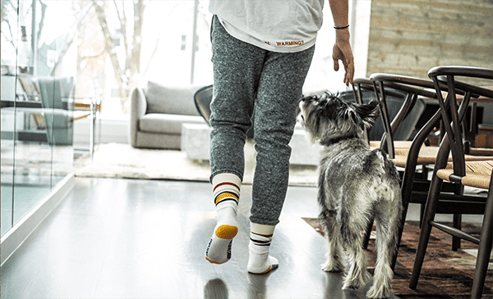Taking the time to sit down with everyone in your household and deciding on a set of House Rules for your new dog is paramount to making sure they succeed and become a well-behaved member of the family.
It can be very confusing for your dog if everyone in your home has different rules for them. For example, if one person allows them on the furniture, and another person yells at them when they jump up on the couch to cuddle. Or if one person holds off on putting down meals until pup offers a "sit," but everyone else just plops down the bowl when it's feeding time.

If your rule is that your dog isn't allowed in the kitchen because there are just too many potential dog hazards in there (e.g., xylitol, chip and other snack bags, medications on the countertops, etc.) and somebody else in your home gives your dog free roam of the kitchen, there can be some very serious (and heartbreaking) consequences.
Similarly, if you're trying to train your dog to "sit" (or even better ... "go to place") before you open the front door, and other people in your home aren't, not only will your training efforts be in vain, but your pup may bolt out the door, only to get lost or injured. So establishing "house rules," and doing so early on and with everyone's "buy in," is important for many reasons.
The customizable worksheet below makes it easier to come up with the rules that will work best for your family and your home by providing some "starter rules" and things to consider as a family, so your dog’s house rules can be agreed upon and established early on, so everybody can get down to the serious business of having fun with your new furry addition!
 Where will your dog sleep? (Examples: In their crate (and where will that be?), on their own dog bed outside of the crate, in bed with people)
Where will your dog sleep? (Examples: In their crate (and where will that be?), on their own dog bed outside of the crate, in bed with people)
Are there any rooms or areas your dog isn’t allowed? (Examples: Upstairs, Basement, Bedrooms, Kitchen, Dining Room, Yard)
Is your dog allowed on the furniture? If yes, are they only allowed on specific furniture or all furniture? (Examples: only on couch, only on certain chair)
Where will your dog’s safe space be located?
What must your dog do to go through doors and gates? (All dogs should be taught to wait until given permission to go through doors and gates. This will help prevent your pup from door-dashing in the future. Examples: Dog must Sit and Stay, Dog must Down and Stay)
When guests visit, what happens with your dog? (Do you keep them crated? In their safe space?)
What are your dog’s rules for greeting visitors? (For example: no jumping, staying quiet)
Who will exercise your dog and when? How will they exercise your dog? (Walk, Fetch, Tug, etc.)
Who is in charge of training your dog? (We recommend everyone in the household practice training with the dog.)
When will training sessions take place? (Examples: Before mealtimes, after school, 6:30pm)
Who is in charge of your dog’s grooming needs? (This includes: coat brushing, nail trimming, teeth brushing, ear cleaning, and body checks.)
Who is in charge of cleaning up your dog’s poop? If you have a yard, how often is it cleaned up? (After every instance, daily, or weekly?)

Where will your dog eat their meals?
What time will your dog eat their meals?
Who is responsible for feeding and ensuring their water bowl is always full?
Is your dog allowed to have human table scraps? (If you can’t resist giving your pup a tidbit from your dinner plate, think about giving vegetables like plain carrots, green beans, or peas as their “human food” snack. Never give grapes, raisins, or currants! These fruits can be toxic to dog's kidneys.)
What types and how many dog treats is your dog allowed to have?
Simply fill out the form below, and our Dog Training House Rules worksheet will be sent to your inbox. Once you've filled out the worksheet, it's a great thing to post somewhere visible for everyone in your family to reference.
